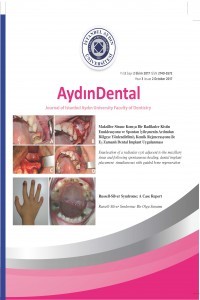TREATMENT OF SKELETAL CLASS II DIVISION II MALOCCLUSION WITH ACTIVATOR AND FIXED ORTHODONTIC APPLIANCES: A CASE REPORT
The aim of this case report; is to present the treatment of a male patient with skeletal Class II, dental Class II division II associated with deep bite by the using of functional appliance through a short period of fixed orthodontic treatment. A 14-year 4-month old male patient applied for treatment in our clinic with a cheef complains of retrognathic mandible. The radiographic and clinical examinations and evaluations showed skeletal class II anomalies. Dental class II division II anomaly with increased over bite had been identified. The orthodontic treatment started with functional appliance as activator. After 8 months mandibular advanced and Class I molar and canine relationship had been achieved. after functional treatment 0.018 slot straight wire Roth brackets applied for both the upper and the lower teeth. After 6 months for both jaws a 0.016 x 0.022 stainless steel wire had been applied. After that the intrusion of the incisive teeth had been achieved by using CIA. In order to achieve a Class I molar and canine relationship, Class II elastics had been used at the end of the treatment. A case with a skeletal class II and Dental class II division II with increased over bite was treated through a 2 years and 8 month of treatment and dental class I relationship with normal overbite and overjet and good occlusion achieved at the end of the treatment.
Anahtar Kelimeler:
Class II division 2, Deep-bite, Functional therapy, Connecticut intrusion arch (CIA)
___
- [1] Acar Güngör A. Sınıf II maloklüzyonların tedavisinde molar distalizasyonu. EÜ Dişhek Fak Derg 2006;27:97-105. [2] Ast DB, Alaway M, Darker HL. The prevalence of malocclusion, related to dental caries and lost first permanent molars, in a fluoridated city and a fluoride deficientcity. Am J Orthod 1962;48:106-13. [3] Vargervik K, Harvold EP. Response to activator treatment in class II malocclusions. Am J Orthod 1985; 88: 242-251. [4] Arvystas MG. Nonextraction treatment of severe class II, division 2 malocclusions. Am J Orthod Dentofacial Orthop 1991; 99: 74-84. [5] Epker BN, Fish CF. The surgicalorthodontic correction of mandibular deficiency. Part I. Am J Orthod 1983; 84:408-21. [6] Epker BN, Fish CF. The surgicalorthodontic correction of mandibular deficiency. Part II. Am J Orthod 1983;84: 491-507. [7] Harnick DJ. Case report: Class II correction using a modified Wilson bimetric distalizing arch and maxillary second molar extraction. Angle Orthod 1998; 68: 275-280. [8] Bishara SE. Textbook of orthodontics. 1st Ed., Saunders, Philadelphia, USA, 2001, 354-361. [9] Graber TM, Vanorsdall R, Vig K. 2000. Orthodontics: Current Principles and Techniques, Third Edition St. Louis, Toronto, London: The C.V. Mosby. Comp. [10] Proffit WR, Fields HW, Ackerman JL, Bailey LJ, Tulloch JFC. 2000. Contemporary Orthodontics, Third Edition St. Louis, Toronto, London: The C.V. Mosby Comp. [11] Graber T. 1997. Functional Analysis. Graber T, Petrovic A, (Ed.). Dentofacial Orthopedics with Functional Appliances, pages, 125-160. Baltimore, Boston: Mosby- Year Book, Inc. [12] Engel G, Cornforth G, Damerell JM, Gordon J, Levy P, McAlpine J. et al. 1980. Treatment of deep-bite cases. Am J Orthod, 77(1): 1-13. [13] Arvystas MG. 1990. Nonextraction treatment of severe class II, division 2 malocclusions. Part 1. Am J Orthod Dentofacial Orthop, 97(6): 510-521. [14] Bishara SE, Jamison JE, Peterson LC, DeKock WH. 1981. Longitudinal changes in standing height and mandibular parameters between the ages of 8 and 17 years. Am J Orthod, 80(2): 115-135. [15] Engel G, Cornforth G, Damerell JM, Gordon J, Levy P, McAlpine J. et al. 1980. Treatment of deep-bite cases. Am J Orthod, 77(1): 1-13. [16] Sharma NS. Management of growing skeletal class II patient: A case report. Int J Clin Paediatr Dent 2013; 6:48-54. [17] Dağsuyu ĠM. Sınıf II Bölüm 1 maloklüzyonlu bireylerde fonksiyonel ortopedik tedavi etkilerinin aksiyografik ve sefalometrik yöntemlerle incelenmesi. J Dent Fac Atatürk Uni 2011;21:196-212. [18] Özel N AA. Sınıf II maloklüzyonların tedavisinde kullanılan fonksiyonel ortopedik apareyler. Smyrna Tıp Dergisi 2011:48-52 [19] Nanda R. 2005. Management of Deep Overbite Malocclusion (chapter 7). Biomechanics and esthetic strategies in clinical orthodontics: Elsevier inc. [20] Tausche E, Luck O, Harzer W. 2004. Prevalence of malocclusions in the early mixed dentition and orthodontic treatment need. Eur J Orthod, 26(3): 237-244. [21] Burstone CR. 1977. Deep overbite correction by intrusion. Am J Orthod, 72(1): 1-22. [22] Kim TW, Kim H, Lee SJ. 2006. Correction of deep overbite and gummy smile by using a mini-implant with a segmented wire in a growing class II division 2 patient. Am J Orthod Dentofacial Orthop, 130(5): 676-685.
- ISSN: 2149-5572
- Yayın Aralığı: Yılda 3 Sayı
- Başlangıç: 2015
- Yayıncı: İstanbul Aydın Üniversitesi
